From Eat the Weeds
and other things, too
by Green Deane
Syzygium: A Jumble of Jambul
Syzygium spp.
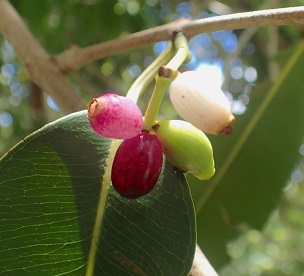
Jambul, species Syzygiym cumini, ripens from white to dark purple
The Jambul tree makes you wonder what people were thinking.
For
a half a century or so the United States Department of Agriculture
brought into Florida many species the state now considers problem
plants. Jambul is one of them. It was introduced into south
Florida as a shade tree, not once but three times, 1911, 1912 and 1920.
It took 71 years for the species to become a naturalized pest and now a
century later full-grown specimens can be found the warm south of the
state to central Florida. Not bad for a tropical tree.
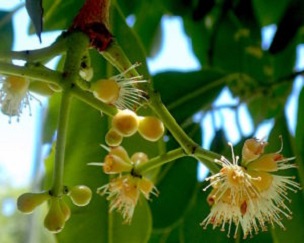
Jambul blossom in July
The
species has been introduced into most warm areas of the world. However,
in Hawaii it probably got there by migrating mynah birds and was first
recorded on the islands in 1870. That state is trying to eradicate it.
Jambul was also cultivated throughout the Caribbean and got to Puerto
Rico in the 1920s, where it’s naturalized as well. Because of its
later introduction there it is one of the few genera in the Caribbean
that is not used much in local folk medicine (though very present in
native India medicine.) As a forager there is little I can do about the
genus except my civic duty and eat as many of its fruit as possible to
reduce its spread. Actually there are at least two species of Syzygium
naturalized in Florida, the S. cumini that bears dark purple fruit, above, and S. jambos, below, which has white to red fruit. Both species are called the Jambul tree (jam-BULL.)
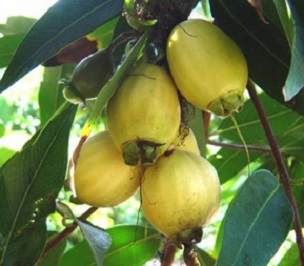
Jambul, species Syzygium jambos
A
native of south Asia and Australia Jambul produces food, wood products,
and materials for folk medicine. The dark fruit of the S. cumini tastes
and smells like a ripe apricot but looks like a stretched black olive,
very juicy and to me puckery like a chokecherry. The S. jambos
has pearish-shaped fruit that ranges from white to green to yellow to
red. Its flavor is more like an apple/green pepper cross with a rose
scent and a slightly bitter aftertaste. It’s skin is thin, waxy,
and the hollow core contains a small amount of inedible fluff.
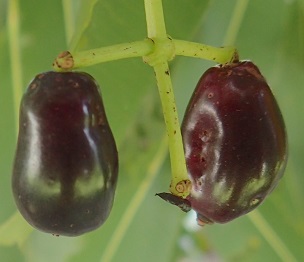
Ripe Jambul (Syzygium cumini) fruit
Jambul
fruit, which are high in vitamins C, can be eaten out of hand or
made into sauces, tarts and jams. They make a good fruit sherbet, syrup
and squash. They can be made into vinegar, wine or distilled, one
native spirit being “jambava.” It is also a good honey
tree. Harvesting of fruit in its native range is in summer or early
fall. Here in Florida it tends to be in spring to summer. The
leaves make good livestock feed and oil in the leaves has been used to
scent soaps and perfumes. The bark yields a brown dye and has tannin
for leather making. The wood is very durable to water. It’s used
used to make beams, rafters, telephone poles, oars, ship masts, boats,
and water troughs, among many more uses.

Terminal leaves are always in pairs
Often planted as a windbreak, the S. cumini trees
can reach full height in 40 years, which in their native rage is near
100 feet. In Florida it is half that. It can have a crown 18 to
40 feet wide and often has multiple trunks radiating from near the
ground. The Jambul can also grow in wet and dry areas as long as
it has sun. The bark on the lower part of the tree is discolored, rough
textured, cracked and flaking; young bark higher up is smooth and light
gray. The paired, opposite leaves have a hint of turpentine when
crushed. The evergreen leaves are two to ten inches long, one to four
inches wide, oblong in shape, oval or elliptic, can be blunt or
tapering to a point at the tips. The leaves start out pinkish then
mature leathery and glossy, dark green above, light green below. Each
leaf has a yellowish midrib. The S. jambos tends to be shorter, perhaps 45 feet at best in its native range, its leaves are more lance shaped, and the bark a smooth gray.
Medicinally
the seeds of the Jambul have been used to control blood sugar levels
and the leaves and bark high blood pressure. Incidentally, we regularly
used another member of this genus, S. aromaticum. Its dried flower buds form the spice we know as “cloves.”
As is often the case the botanical name is Greek tainted by Latin. Syzygium
is said to refer to the tree’s paired leaves, one also sees
“twin” leaves. The base word, however, is zygos (zi-GHOS)
the yoke. A person’s spouse in Greece is called my Zizigos
(ZEE-zee-ghos) my yoke mate. So the Greek speaker would be strongly
tempted to pronounce Syzygium as zee-ZEE-ee-yum. Anglicized Latin would have it sizz-ZYE-gee-um.
The species name cumini,
said KOU-mee-nee, is from the Greek kyminon (KEY-mee-on) or in modern
Greek Kymino (KEY-mee-no) meaning the spice cumin. Jambos
(jam-BOS) is the Malaysian name for rose-apple though it comes from
Sanskrit’s Jambudvīpa, which means rose apple land.
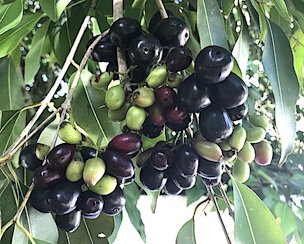
The Java Plum, or Jambul Fruit, is very high in tannins.
What
can be said about the Jambul Tree? First, if you don’t like the name
you can call it the Java Plum. The Indians prefer Jamun. The tree also
demonstrates quite a few principles. One is that the toxin is often on
the outside. Why? Because that is where insects, birds and other
animals attack first. This is why green potatoes can make you sick if
you eat the skins. In the case of the Jambul Tree the skin of the sweet
fruit is loaded with tannin, about 10 times more than a red grape. So
they are edible but there is a bitter astringency. Sprinkling with salt
or soaking in salted water can reduce that. More on that in a moment.
Another
principle being demonstrated this year is that Mother Nature rules.
Last year the edible terrestrial mushroom season was off by six weeks
because seasonal rains were either late or light. Last year the Jambul
Trees fruited in early August. This year the rains have been iffy as is
the fruiting. Foraging includes, among many skills, watching the
weather. The major impediment to the tree — though it is a commercial
fruit — is the tannins. Salt does mitigate that some when eating them
fresh and is reported to lower blood glucose levels. Making wine out of
the fruit is a challenge because of the tannin. Often when you make
wine you have to add tannin. In this case one has to use strategies to
reduce the tannin. This ranges from yeast selection to finding agents
that grab onto the large tannin molecules and help them sink to the
bottom so they can be left there.
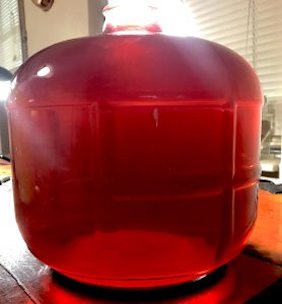
Two and a half gallons of Jambul Wine before racking.
Green Deane’s “Itemized” Plant Profile
Identification: S. cumini is a tree to 50 feet, S. jambos smaller, both often multiple trunks, bark on the lower part of S. cumini is discolored, rough textured, cracked and flaking, young bark higher up is smooth and light gray, bark on S. jambos smooth and gray. Paired opposite leaves have a hint of turpentine when crushed. The evergreen leaves of the S. cumini
are two to ten inches long, one to four inches wide, oblong in shape,
oval or elliptic, can be blunt or tapered to a point at tips, leaves of
the S. jambos more lance
shaped. Leaves start out pinkish then mature leathery and glossy, dark
green above, light green below. Each leaf has a yellowish midrib.
Time of Year: Summer and fall in native range, late spring and summer in Florida area.
Environment: Likes sun, can tolerate wet and dry conditions, does not tolerate freezes unless full grown then iffy.
Method of Preparation: Fruit out of hand, or use as any fruit as jelly, sauce, syrup, wine, spirits and vinegar.
Green Deane's Disclaimer
Information
contained on this website is strictly and categorically intended as a
reference to be used in conjunction with experts in your area. Foraging
should never begin without the guidance and approval of a local plant
specialist. The providers of this website accept no liability for the
use or misuse of information contained in this website.
Back to
Jambolan Page
|
|






